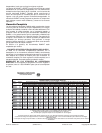
If you have any questions, call 1-800-4-DEWALT (1-800-433-9258)
English
9.6, 12, 14.4, 18 Volt Heavy Duty
Flashlights
DW902 (9.6 V), DW904 (12 V), DW906 (14.4 V),
DW908 (18 V)
– Extra bulb stored in light behind
lens.
– Use with D
EWALT power packs and
chargers (both sold separately).
IF YOU HAVE ANY QUESTIONS OR COMMENTS ABOUT THIS
OR ANY DeWALT TOOL, CALL US TOLL FREE AT:
1-800-4-DEWALT (1-800-433-9258)
NOTE: D
EWALT heavy duty flashlights operate on the following
battery packs.
WARNING: When using electric tools, basic safety precautions
should always be followed to reduce risk of fire, electric shock,
and personal injury, including the following:
READ ALL INSTRUCTIONS
Safety Rules for Heavy Duty Flashlights
WARNING: DO NOT OPERATE FLASHLIGHT OR CHARGER
NEAR FLAMMABLE LIQUIDS OR IN GASEOUS OR
EXPLOSIVE ATMOSPHERES. INTERNAL SPARKS MAY
IGNITE FUMES.
WARNING: Lens and bulb become hot during use.
• During or immediately after use, don’t lay flashlight flat on lens
surface.
• Don’t touch lens surface when bulb is lit.
• Handle flashlight with care around any flammable surface.
• If bulb has been lit, let flashlight cool for several minutes
before changing bulb.
Safety Rules for Chargers
1. Before using charger, read all instructions and cautionary
markings on (1) charger, (2) battery pack, and (3) product
using battery pack.
2. DANGER: 120 volts present at charging terminals. Do not
probe with conductive objects. Danger of electric shock or
electrocution.
3. If battery pack case is cracked or damaged, do not insert into
charger. Danger of electric shock or electrocution.
4. The charger and battery pack are specifically designed to
work together. DO NOT attempt to charge the battery pack
with any chargers other than the ones in this manual.
5. Do not expose charger to rain or snow.
6. To reduce risk of damage to electric plug and cord, pull by
plug rather than cord when disconnecting charger.
7. Make sure cord is located so that it will not be stepped on,
tripped over, or otherwise subjected to damage or stress.
8. An extension cord should not be used unless absolutely
necessary. Use of improper extension cord could result in risk
of fire, electric shock, or electrocution.
9. Two wire cords can be used with 2 or 3 wire extension cords.
Only round jacketed extension cords should be used, and we
recommend that they be listed by Underwriters Laboratories
(U.L.) (C.S.A. in Canada.) The letters WA on the cord jacket
indicate that the cord is suitable for outdoor use.
10. An extension cord must have adequate wire size (AWG or
American Wire Gauge) for safety. The smaller the gauge
number of the wire, the greater the capacity of the cable, that
is 16 gauge has more capacity than 18 gauge. When using
more than one extension to make up the total length, be sure
each individual extension contains at least the minimum wire
size.
CHART FOR MINIMUM WIRE SIZE (AWG) OF EXTENSION CORDS
NAMEPLATE RATING AMPS - 0 - 10.0
Total Extension Cord Length (feet) 25 50 75 100 125 150 175
Wire Gauge 18 18 16 16 14 14 12
11. The charger is ventilated through slots in the top and the
bottom of the housing. Do not place any object on top of the
charger or place the charger on a soft surface that might block
the ventilation slots and result in excessive internal heat.
Place the charger in a position away from any heat source.
12. Do not operate charger with damaged cord or plug — have
them replaced immediately.
13. Do not operate charger if it has received a sharp blow, been
dropped, or otherwise damaged in any way; take it to an
authorized DeWalt service center.
14. Do not disassemble charger; take it to an authorized DeWalt
service center when service or repair is required. Incorrect
reassembly may result in a risk of electric shock, electrocution
or fire.
15. To reduce risk of electric shock, unplug charger from outlet
before attempting any cleaning. Removing the battery pack
will not reduce this risk.
16. NEVER attempt to connect 2 chargers together.
17. DO NOT store or use the tool and battery pack in locations
where the temperature may reach or exceed 105°F (such as
outside sheds or metal buildings in summer).
18. The charger is designed to operate on standard household
electrical power (120 volts). Do not attempt to use it on any
other voltage!
Safety Rules for Batteries
1. Do not incinerate the battery pack even if it is severely
damaged or is completely worn out.The battery pack can
explode in a fire.
2. A small leakage of liquid from the battery pack cells may occur
under extreme usage or temperature conditions. This does
not indicate a failure. However, if the outer seal is broken and
this leakage gets on your skin:
a.Wash quickly with soap and water.
b.Neutralize with a mild acid such as lemon juice or
vinegar.
c.If battery liquid gets into your eyes, flush them with clean
water for a minimum of 10 minutes and seek immediate
medical attention. (Medical note: The liquid is 25-35%
solution of potassium hydroxide.)
3. Never attempt to open the battery pack for any reason. If the
plastic housing of the battery pack breaks or cracks,
immediately discontinue use and do not recharge.
4. Do not carry extra battery packs in aprons, pockets, or tool
boxes along with other metal objects. Battery pack could be
short circuited causing damage to the battery pack and
possibly causing severe burn or fire.
NOTE: Battery storage and carrying caps are provided for use
whenever the battery is out of the tool or charger. Remove cap
before placing battery in charger or tool.
WARNING: Do not store or carry battery so that metal










